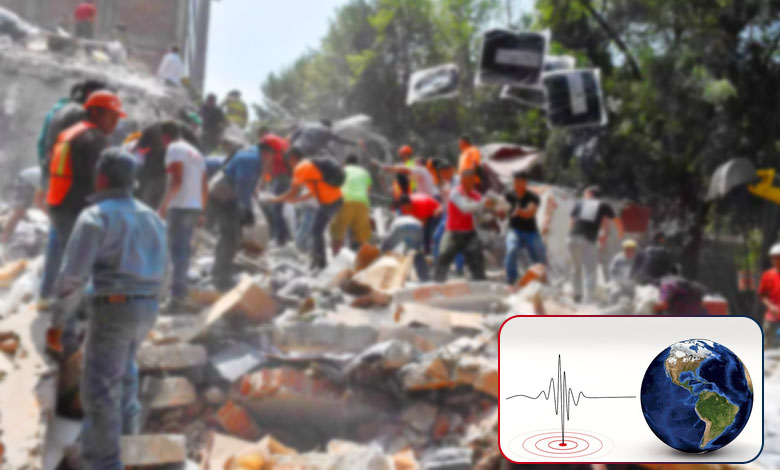Nepal-Tibet Earthquake: 126 Lives Lost, Hundreds Injured, over 1000 Houses Collapsed
A powerful 7.1-magnitude earthquake struck the Nepal-Tibet border, killing at least 126 people, injuring 188, and causing the collapse of over 1000 houses. Tremors were felt across northern India, and aftershocks followed. Rescue efforts are underway in the seismically active region.

A powerful earthquake struck the Nepal-Tibet border region, resulting in devastating consequences. The earthquake, with a magnitude of 7.1, has claimed the lives of at least 126 people and left 188 others injured, according to media reports.
The quake has caused widespread destruction, including the collapse of over 1000 houses. The tremors have affected both Nepal and Tibet, raising serious concerns about the region’s vulnerability to seismic activity.
Details of the Earthquake’s Impact
The earthquake occurred at 6:35 a.m. IST on Tuesday, with its epicenter located at latitude 28.86°N and longitude 87.51°E, at a depth of 10 kilometers. The epicenter was identified in Xizang (Tibet Autonomous Region), near the Nepal border.
The National Centre for Seismology (NCS) confirmed the details of the earthquake, which struck a region already known for its seismic activity.
Casualties and Damage in Tibet and Nepal
Xinhua news agency reported that the majority of fatalities occurred in the city of Xizang, where significant injuries and structural damage were also recorded. The quake caused widespread devastation, including the collapse of several homes.
In Tonglai Village, located in Changsuo Township of Dingri in Xigaze (Shigatse), many houses collapsed, leaving families stranded and in dire need of assistance.
The earthquake has also had a profound impact on the region’s infrastructure, with numerous buildings, roads, and vital facilities sustaining significant damage. As rescue operations continue, authorities are working to provide immediate relief to the affected populations.
Tremors Felt Across Northern India
The earthquake was not limited to Nepal and Tibet. Tremors were felt across northern India, including areas such as Bihar, West Bengal, Sikkim, and Delhi-NCR. The sudden shaking caused panic as residents rushed out of their homes, seeking safety.
Fortunately, there have been no reported casualties or property damage in India so far, though the situation remains under close observation.
Aftershocks and Continued Seismic Activity
In the aftermath of the initial earthquake, two significant aftershocks followed. The first, a 4.7-magnitude tremor, struck at 7:02 a.m. IST, with an epicenter at latitude 28.60°N and longitude 87.68°E, at a depth of 10 kilometers.
The second aftershock, measuring 4.9 in magnitude, occurred just five minutes later at 7:07 a.m. IST. Its epicenter was located at latitude 28.68°N and longitude 87.54°E, at a depth of 30 kilometers.
These aftershocks have caused further concern, particularly in areas already reeling from the initial impact. Authorities have warned of the potential for more aftershocks and are urging residents to stay alert.
Geological Context: Nepal’s Vulnerability to Earthquakes
Nepal is situated in a seismically active zone, where the Indian and Eurasian tectonic plates converge. This tectonic activity, responsible for forming the Himalayan mountain range, frequently results in seismic events of varying magnitudes.
The region has experienced several significant earthquakes in the past, and this latest tremor has reminded residents and authorities alike of the ongoing risks posed by tectonic forces.
Nepal’s vulnerability to earthquakes is compounded by its mountainous terrain, which often complicates rescue efforts and infrastructure development. As such, the country remains on high alert during seismic events, with authorities continually working to enhance disaster preparedness and response capabilities.
Also Read | 7.1 Magnitude Earthquake Jolts Nepal; Tremors Felt Across North India\
Rescue Operations and International Support
In the wake of the earthquake, rescue operations have been launched to assist those affected by the disaster. Local authorities, as well as national and international aid organizations, are mobilizing resources to provide immediate assistance, including medical aid, food, and shelter to the victims.
The government of Nepal has expressed its commitment to providing all necessary resources to aid the affected population. Furthermore, neighboring countries, including India, have offered their support and assistance in the form of rescue teams and relief supplies.
The Role of Technology in Earthquake Monitoring
In light of this recent earthquake, the use of technology to monitor seismic activity has proven to be invaluable. The United States Geological Survey (USGS) was among the first to pinpoint the location of the earthquake, identifying it as being 93 kilometers northeast of Lobuche, near the Nepal-Tibet border. The Khumbu Glacier, situated 150 kilometers east of Kathmandu and near Everest Base Camp, was located in the vicinity of the tremor.
Advanced earthquake monitoring systems, including seismic sensors and satellite-based technologies, have allowed for real-time data collection and analysis, providing authorities with the necessary information to respond effectively to the situation.
